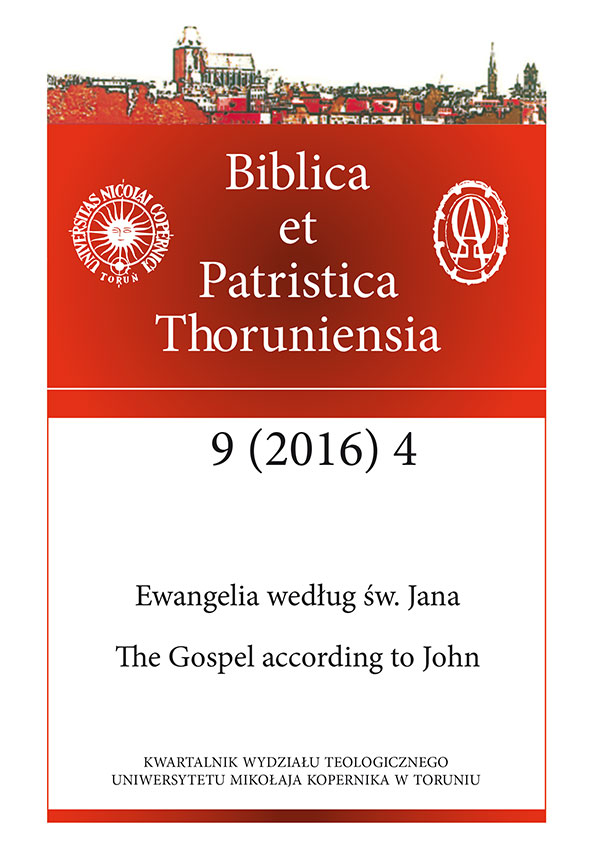“Jesus in the Image of God“ – The Form of Early Christian Monotheism Illustrated on the Image of the Shepherd in the Gospel of John
DOI:
https://doi.org/10.12775/BPTh.2016.032Keywords
monoteizm, ewangelia Jana, metafora, aluzjaAbstract
As Christians, we are perhaps used to speaking about the Trinitarian God, the Father, the Son, and the Holy Spirit, and thinking of it as a unity. But through faith, the first disciples had to overcome a high hurdle of stringent Jewish monotheism to be able to confess God´s sonhood in Jesus of Nazareth and, as a result, his divinity. How this process occurred is, above all, of interest to the history of dogma. The answer to this question can and must be given by the exegesis. The exegesis uses different methods in its scientific effort to better understand biblical texts. Unfortunately, no single methodical access to Holy Scripture reveals all of its content, aspects, and information, which one could obtain through it. In the following article, using as example the parable “The Good Shepherd”, it will be demonstrated, how one can methodically obtain, step by step, the answer to the question about the form of early Christian monotheism from the New Testament texts. For this purpose, the procedure of interpretation of R. Zimmerman’s metaphor will be presented, and from its results, theologically concluded.
References
Novum Testamentum Graece, E. i E. Nestle – K. i B. Aland (red.), Stuttgart 1993.
Für die deutsche Übersetzung der biblischen Texte
Neue Jerusalemer Bibel. Einheitsübersetzung mit dem Kommentar der Jerusalemer Bibel, A. Deissler, A. Vögtle (red.), Freiburg i. Breisgau 2007.
Stenzel, J., Art. Anspielung (2), Reallexikon der dt. Literaturwissenschaft I (1997), 93–96.
Barrett C.K., Das Evangelium nach Johannes, KEK Sonderband, Göttingen 1990.
Bauer W., Das Johannesevangelium, HNT 6, Tübingen 1933.
Bultmann R., Das Evangelium des Johannes, KEK, Göttingen 1964.
Gnilka J., Johannesevangelium, NEB.NT 4, Würzburg 1989.
Moloney F.J., The Gospel of John, Sacra Pagina Series 4, Collegeville 1998.
Schnackenburg R., Das Johannesevangelium, HThK.NT IV/1–4 (Sonderausgabe), Freiburg 1979.
Schneider J., Das Evangelium nach Johannes, ThHK Sonderband, aus d. Nachlass – E. Fascher (red.), Berlin 1976.
Schnelle U., Das Evangelium nach Johannes, ThHK.NT 4, Leipzig 2004.
Thyen H., Das Johannesevangelium, HNT 6, Tübingen 2005.
Wikenhauser A., Das Evangelium nach Johannes, RNT 4, Regensburg 31961.
Beutler J., Der alttestamentlich-jüdische Hintergrund der Hirtenrede in Joh 10, w: The Shepherd Discourse of John 10 and Its Context. Studies by members of the Johannine Writings Seminar, J. Beutler – R.T. Fortna (red.), SNTS.MS 67, New York 1991, s. 18–32.
Hartl J., Metaphorische Theologie. Grammatik, Pragmatik und Wahrheitsgehalt religiöser Sprache, Studien zur systematischen Theologie und Ethik 51, Berlin 2008.
Kayser W., Das sprachliche Kunstwerk. Eine Einführung in die Literaturwissenschaft, Bern 31954.
Kowalski B., Die Hirtenrede (Joh 10,1–18) im Kontext des Johannesevangeliums, SBB 31, Stuttgart 1996.
Scheffczyk L., Grundlagen des Dogmas. Einleitung in die Dogmatik, Aachen 1997.
Schlatter A., Der Evangelist Johannes. Wie er spricht, denkt und glaubt, Stuttgart 31960.
Schnelle U., Einleitung in das Neue Testament, UTB 1830, Göttingen 2005.
Thüsing W., Das Gottesbild des Neuen Testaments, w: Studien zur neutestamentlichen Theologie, T. Söding (red.), WUNT 82, Tübingen 1995, s. 59–86.
Zimmermann R., Metapherntheorie und biblische Bildersprache. Ein methodologischer Versuch, ThZ 56 (2000), s. 108–133.
Zimmermann R., Einführung: Bildersprache verstehen oder Die offene Sinndynamik der Sprachbilder, w: Bildersprache verstehen. Zur Hermeneutik der Metapher und anderer bildlicher Sprachformen, R. Zimmermann (red.), Übergänge, 38, München 2000, s. 13–54.
Zimmermann R., Paradigmen einer metaphorischen Christologie. Eine Leseanleitung, w: Metaphorik und Christologie, J. Frey – J. Rohls – R. Zimmermann (red.), Theologische Bibliothek Töpelmann 120, Berlin 2003, s. 1–34.
Zimmermann R., Jesus im Bild Gottes. Anspielungen auf das Alte Testament im Johannesevangelium am Beispiel der Hirtenbildfelder in Joh 10, w: Kontexte des Johannesevangeliums. Das vierte Evangelium in religions- und traditionsgeschichtlicher Perspektive, J. Frey, U. Schnelle (red.), WUNT 175, Tübingen 2004, s. 81–116.
Zimmermann R., Christologie der Bilder im Johannesevangelium. Die Christopoetik des vierten Evangeliums unter besonderer Berücksichtigung von Joh 10, WUNT 171, Tübingen 2004.
Zimmermann R., Imagery in John: Opening up Paths into the Tangled Thicket of John's Figurative World, w: Imagery in the Gospel of John: Terms, Forms, Themes and Theology of Johannine Figurative Language, J. Frey (red.), WUNT 200, Tübingen 2006, s. 1–43.
Downloads
Published
How to Cite
Issue
Section
License
CC BY ND 4.0. The Creator/Contributor is the Licensor, who grants the Licensee a non-exclusive license to use the Work on the fields indicated in the License Agreement.
- The Licensor grants the Licensee a non-exclusive license to use the Work/related rights item specified in § 1 within the following fields: a) recording of Work/related rights item; b) reproduction (multiplication) of Work/related rights item in print and digital technology (e-book, audiobook); c) placing the copies of the multiplied Work/related rights item on the market; d) entering the Work/related rights item to computer memory; e) distribution of the work in electronic version in the open access form on the basis of Creative Commons license (CC BY-ND 3.0) via the digital platform of the Nicolaus Copernicus University Press and file repository of the Nicolaus Copernicus University.
- Usage of the recorded Work by the Licensee within the above fields is not restricted by time, numbers or territory.
- The Licensor grants the license for the Work/related rights item to the Licensee free of charge and for an unspecified period of time.
FULL TEXT License Agreement
Stats
Number of views and downloads: 581
Number of citations: 0



